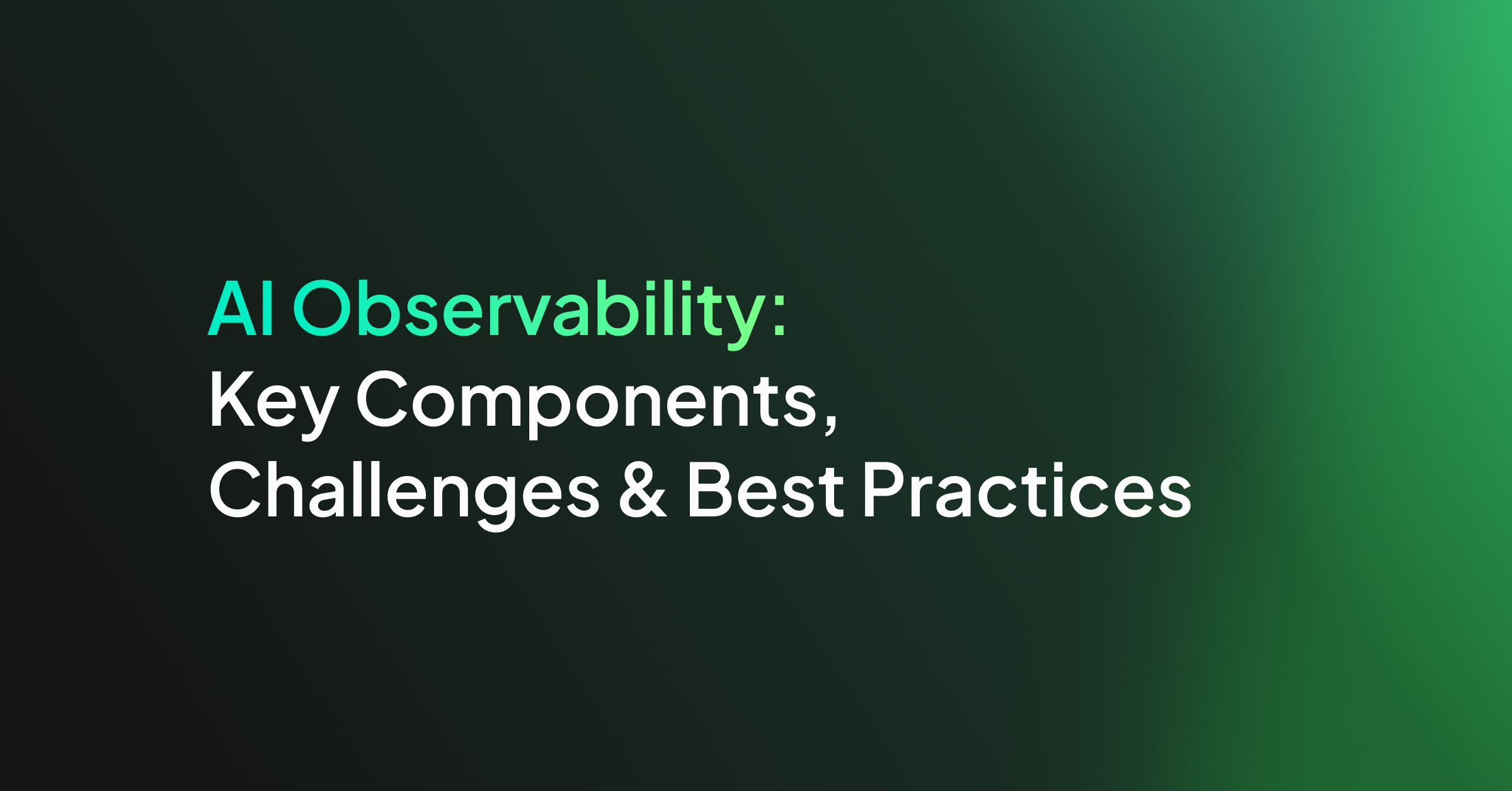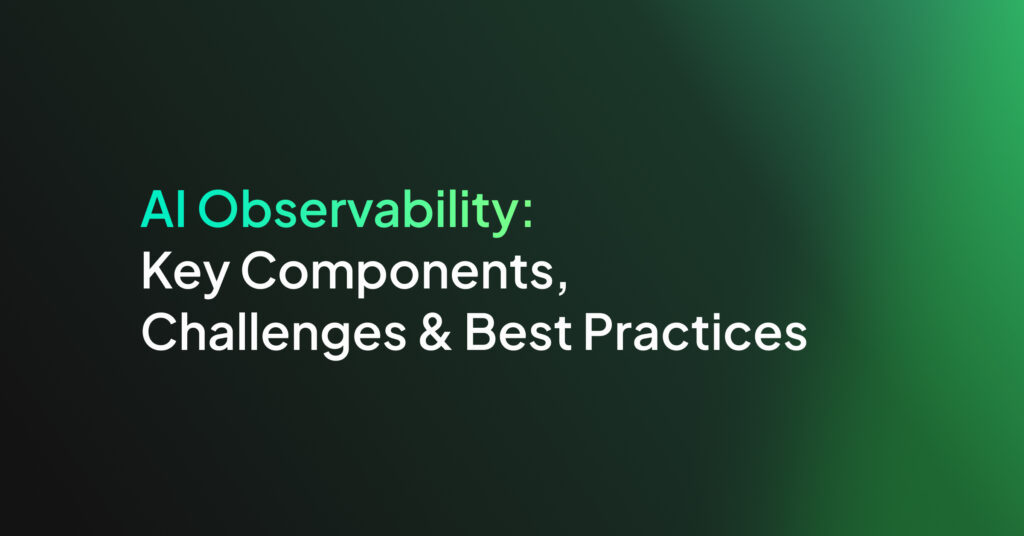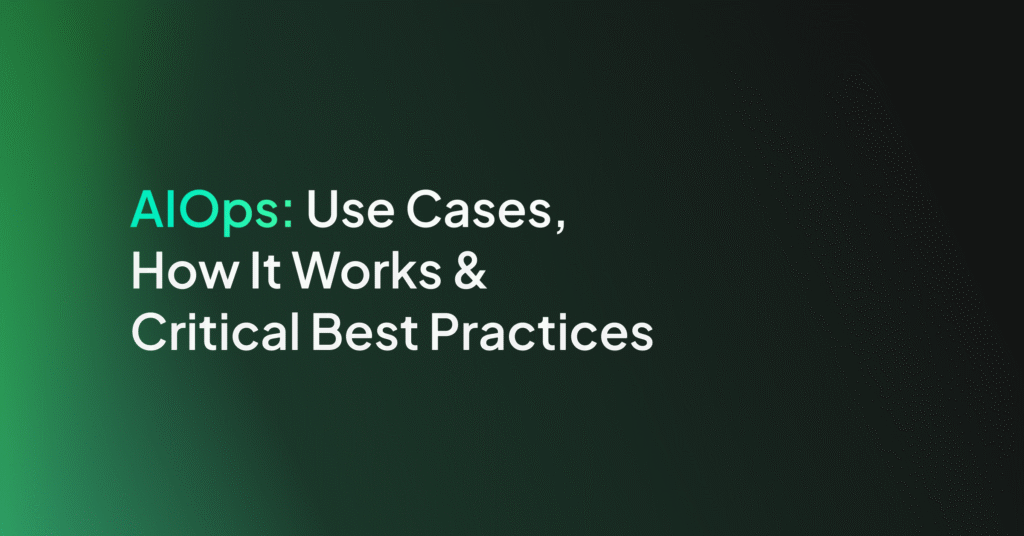AI Observability: Key Components, Challenges & Best Practices

The Importance of AI Observability
With observability, organizations can improve their troubleshooting capabilities, reducing downtime and improving user experience. This is crucial in minimizing risks associated with AI deployment, allowing organizations to quickly rectify anomalies or potential biases that may arise in a model’s inference process.
As AI systems become more integral to decision-making processes, observability ensures these decisions are made transparently and ethically. It cultivates customer trust by demonstrating organizations’ commitment to responsible AI use. Observability also aids in providing detailed analytics that inform adjustments, improvements, or scale-ups.
Key Components of AI Observability
Data Quality Monitoring
Data quality monitoring involves continuous tracking of data inputs for errors, missing values, and inconsistencies, which can significantly affect model outcomes. Data quality monitoring is vital to prevent these issues from skewing model predictions and to ensure the system’s decisions are based on accurate and relevant data.
Model Performance Tracking
Model performance tracking involves measuring key performance indicators (KPIs) such as accuracy, precision, recall, and response time to ensure models are functioning within acceptable parameters. This monitoring helps identify any deviations from expected behavior, hinting at potential issues such as model drift or data quality concerns.
System Resource Utilization
System resource utilization examines how effectively an AI system uses computing resources like CPUs, GPUs, memory, and storage. Monitoring this component helps manage infrastructure costs and ensure models run efficiently without over-utilizing or underutilizing available resources. Consistently tracking these metrics allows organizations to adjust workloads, scale resources appropriately, and avoid bottlenecks that could slow down AI processing.
Explainability and Transparency
Explainability and transparency focus on clarifying and detailing how AI systems make decisions. Explainability tools dissect model predictions to elucidate the factors contributing to specific outcomes. This transparency is vital in building trust with end-users and stakeholders, especially in sectors like healthcare.
Challenges in AI Observability
There are several factors that can make it harder to ensure observability in AI systems:
- Complexity of AI systems: These systems often process vast datasets with multiple data sources, complicating efforts to track their operations. The complexity increases with newer AI technologies, such as neural networks, which function as black boxes, making it difficult to understand their inner workings and ensure they perform as intended. Monitoring AI systems requires sophisticated tools to capture, process, and analyze the operational data generated.
- Data drift and concept drift: Data drift occurs when the statistical properties of input data change, while concept drift refers to alterations in the relationship between input data and outputs. Both can lead to models becoming less accurate as they were trained under previously prevailing data conditions, requiring interventions such as model retraining or adjustments.
- Scalability issues: As organizations increase their AI deployments, maintaining observability while scaling operations becomes complex. Large volumes of data generated by sprawling AI ecosystems can lead to data overload, making it cumbersome to sift through and analyze effectively without affecting responsiveness or incurring excessive costs.
- Integration with existing tools: Integrating AI observability with existing tools is challenging due to compatibility issues and the diverse range of technologies currently in use across organizations. AI systems may require integration with infrastructure monitoring tools, data analytics platforms, or CI/CD pipelines. Each integration point demands careful consideration to ensure interoperability and minimal disruption to existing workflows.
Related content: Read our guide to LLM observability tools (coming soon)
Best Practices for AI Observability
Here are some of the measures that organizations can take to ensure comprehensive AI observability.
Monitor Model Performance Metrics
Monitoring model performance metrics is crucial to ensure AI systems are operating effectively and delivering accurate predictions. Establish a robust system that tracks key performance indicators (KPIs) such as accuracy, precision, recall, F1 score, latency, and throughput. These metrics provide insights into how well the model is meeting its intended objectives. Regular tracking enables the detection of anomalies or performance degradation, which may indicate underlying issues such as overfitting, data drift, or algorithmic inefficiencies.
To enhance this process, employ real-time dashboards that offer a comprehensive view of model performance over time. Visualization tools can help identify trends or abrupt changes, allowing teams to proactively address problems before they escalate. Additionally, configure automated alerts that notify stakeholders when metrics fall below acceptable thresholds. Consider segmenting metrics by different dimensions (e.g., user demographics, geographical regions, or time periods).
Detect Data Drift and Quality Issues
Data drift and quality issues can significantly undermine the reliability of AI models, making it essential to have robust detection mechanisms in place. Data drift occurs when the statistical properties of incoming data deviate from the data on which the model was trained. This can lead to reduced model accuracy, as the model is no longer exposed to the patterns it was designed to learn. Similarly, poor data quality—such as missing values, outliers, or irrelevant features—can skew model predictions and negatively impact outcomes.
To mitigate these risks, implement tools that compare real-time data distributions to training data distributions. Employ statistical measures such as population stability index (PSI), Kullback-Leibler divergence, or Jensen-Shannon divergence to quantify shifts. For data quality monitoring, use automated checks to identify common issues like null values, duplicate entries, or unexpected categorical values. Alerts should be configured to flag these issues early, enabling timely intervention.
Implement System Health Monitoring
AI systems rely on robust hardware and software resources, making system health monitoring a critical component of observability. Poor resource management can lead to performance bottlenecks, increased latency, or system downtime, all of which compromise the reliability of AI deployments. Monitoring system health involves tracking metrics such as CPU and GPU utilization, memory usage, disk I/O, network bandwidth, and storage capacity.
To implement effective system health monitoring, establish baselines that represent normal operating conditions for each resource. Anomalies, such as sudden spikes in memory usage or persistent CPU overutilization, should trigger alerts for investigation. Using centralized observability platforms, integrate these resource metrics alongside model performance metrics to provide a unified view of the system.
Trace Model Predictions Back to Inputs
Tracing model predictions back to their inputs is vital for ensuring transparency, accountability, and explainability in AI systems. This capability, often referred to as lineage tracking, involves mapping the entire workflow that contributes to a prediction—from raw data inputs and preprocessing steps to the specific version of the model used. Such traceability helps organizations understand why a model made a particular decision and is especially critical in regulated industries like finance, healthcare, or criminal justice.
To establish an effective tracing system, log every component of the AI pipeline. This includes data sources, feature engineering steps, model parameters, and intermediate outputs at various stages. Tools that provide visual representations of these dependencies can help teams quickly pinpoint errors or discrepancies. When anomalies occur, lineage tracking enables root-cause analysis by identifying whether the issue stems from corrupted input data, flawed preprocessing, or a model-specific problem.
Integrate Observability into ML Pipelines
Observability should be a foundational element of machine learning (ML) pipelines, ensuring comprehensive monitoring throughout the model lifecycle. This integration involves embedding observability mechanisms at every stage, from data ingestion and preprocessing to model training, evaluation, deployment, and maintenance. Without this end-to-end visibility, organizations risk blind spots that can lead to performance issues or system failures.
To achieve this, design pipelines that automatically log and monitor relevant metrics at each step. For instance, track data quality during ingestion, training loss and accuracy during model development, and prediction latency during deployment. Incorporate observability tools that collect and centralize these logs in a single platform for easier analysis. Additionally, use continuous integration/continuous deployment (CI/CD) systems to ensure that new models or updates are automatically incorporated into the monitoring framework.
Enable Root Cause Analysis for Failures
When AI systems encounter failures or unexpected behavior, root cause analysis (RCA) is essential for identifying and resolving the underlying issues. RCA involves systematically analyzing logs, metrics, and data to determine the origin of a problem—whether it stems from data quality issues, misconfigured infrastructure, or flawed model logic. A well-implemented RCA process minimizes downtime and ensures the reliability of AI systems.
To enable effective RCA, centralize all observability data into a unified platform where logs, metrics, and traces can be correlated. Use anomaly detection tools to highlight patterns or events that may have contributed to the failure. For example, if a model begins producing erroneous outputs, examine data drift metrics to determine whether the incoming data distribution has shifted. Additionally, employ explainability tools to dissect specific predictions and uncover factors influencing incorrect results. By combining automated tools with manual analysis, teams can diagnose problems more accurately and implement targeted fixes.
AI Observability with Coralogix
Coralogix sets itself apart in observability with its modern architecture, enabling real-time insights into logs, metrics, and traces with built-in cost optimization. Coralogix’s straightforward pricing covers all its platform offerings including APM, RUM, SIEM, infrastructure monitoring and much more. With unparalleled support that features less than 1 minute response times and 1 hour resolution times, Coralogix is a leading choice for thousands of organizations across the globe.
See Additional Guides on Key AI Technology Topics
Together with our content partners, we have authored in-depth guides on several other topics that can also be useful as you explore the world of AI technology.
AI Cyber Security
Authored by Exabeam
- AI Cyber Security: Securing AI Systems Against Cyber Threats
- AI Regulations and LLM Regulations: Past, Present, and Future
- Artificial Intelligence (AI) vs. Machine Learning (ML): Key Differences and
Examples
Open Source AI
Authored by Instaclustr
- Top 10 open source databases: Detailed feature comparison
- Open source AI tools: Pros and cons, types, and top 10 projects
- Open source data platform: Architecture and top 10 tools to know
Vector Database
Authored by Instaclustr





